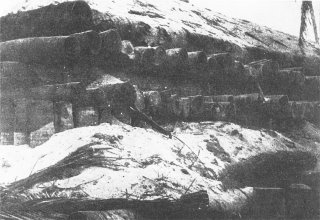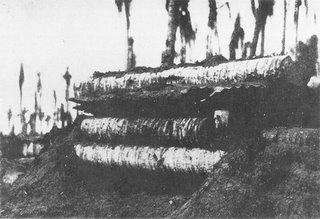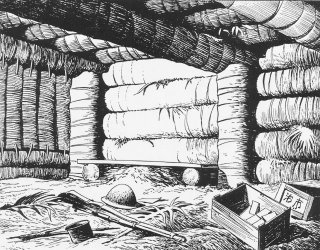Bunkers.

This is coolbert: In the previous blog entry I have mentioned the tremendous naval bombardment prior to the amphibious assault on Tarawa, 1943.
How the naval officers on the scene felt that naval gunfire alone would decide the battle.
And the bombardment from naval gunfire at Tarawa was impressive. I am sure that all observers off shore would have concluded that the operation for the Marines assaulting the island would be a "cake walk". This was proven not to be.
The vast majority of Japanese defending Tarawa escaped the naval bombardment unscathed. Survived to inflict significant casualties on the attacking Marines.
That the Japanese survived the bombardment unscathed was due to the construction of log and earth bunkers. A structure that appears to be unique to the Japanese war effort in WW2 [??]. Bunkers, made of simple and readily available materials that allowed the Japanese defender to survive even the most intense naval gunfire and aerial bombardment.
Log and earth bunkers that U.S. forces encountered all over the Pacific theatre. Whether on Tarawa as encountered by the U.S. Marines, or in New Guinea by the U.S. Army, the log and earth bunker gave a decided advantage to the Japanese defender.
Let me digress and review the pertinent timeless verities of combat as enumerated by De Puy and germane to this blog entry:
# 2 Defensive strength is greater than offensive strength.
Defense is the stronger form of combat. You can do more with less when you are on the defensive.
# 3 Defensive posture is necessary when successful offense is impossible.
By 1943 the Japanese WERE on the defensive in the Pacific, and knew it. Successful defensive was the ONLY option open to them. They had to think and fight defensively.
# 6 Defenders' chances of success are directly proportional to fortification strength.
Defensive success is related to strong fortifications. Earth and log bunkers were very strong defensive fortifications. Gave the Japanese a big plus when on the defensive.
The log and earth bunkers of the Japanese in World War Two [WW2] were formidable defensive structures. A bunker would consist of an outer and inner layer of thick logs, the space in between filled with packed earth, sand, or even coral. A roof would be made in a similar manner, the inner layer of logs for the roof first covered with a thick tarp before a layer of earth was laid over. After the bunker was built, an outer layer of earth was further applied, and then the whole structure camouflaged [camo] in some manner. A firing slit was covered with camo when not in use.

[the above photo shows a portion of how the log and earth bunker was constructed.]
"2. Figure 138 illustrates typical bunker construction. The finished interior of bunkers varies from 4 to 6 feet in height, 6 to 10 feet in width, and 12 to 30 feet in length. The larger bunkers are found sometimes with 2 bays, or compartments, separated by a large solid block of earth. Each bunker has 1 or more narrow firing slits, difficult to hit even at close ranges. Thee slits are covered by some form of camouflage when not in use.
3. In the Buna-Gona area, the bunkers and pillboxes (the latter have also been referred to as small bunkers) were built along the same general lines. With a shallow trench as a foundation, log columns and beams were erected, log revetment walls were constructed, and a ceiling then was made of several layers of logs, laid laterally to the trench. With the completion of this basic superstructure, the revetment walls were reinforced by such materials as sheets of iron, oil drums and ammunition boxes filled with sand, and additional piles of logs. Lastly, the outside was covered with dirt, rocks, coconuts and short pieces of logs. For camouflage, the surface was planted with fast growing vegetation.
Coral rock, better than ordinary rock because it is more resilient, formed part of the protective covering on many of the New Georgia pillboxes (see fig. 144). It was used in conjunction with coconut logs, earth, and miscellaneous materials at hand. A large number of the pillbox tops had as many as four layers of coconut logs which were topped with dirt and coral rock. Ferns and growing shrubs were planted in the chins to round out a well-camouflaged appearance."
Weapons employed from the bunker would include heavy and medium machine guns, supported by riflemen.
These structures were very impervious to American weaponry. A bomb dropped from an aircraft or an artillery or naval gunfire round landing NEAR the bunker would have almost NO effect on the bunker or it's occupants. Japanese inside would be shaken and perhaps dazed, but left more or less combat ready. Even a DIRECT HIT from large caliber weapons might NOT even destroy the bunker, so well build and resilient were these structures!!!

[this second above photo also shows detail of log and earth bunker construction!!]
Keep in mind too that these earth and log defensive bunkers did not exist in a vacuum. They were PART OF AN INTEGRATED DEFENSIVE NETWORK, A WHOLE SERIES OF SUCH STRUCTURES EXISTING N THE BATTLEFIELD, WITH INTERLOCKING FIELDS OF FIRE FOR SUPPORT.
Trying to reduce the earth and log bunkers all throughout the Pacific campaign called for the most extreme combat measures.
NOT ONLY were the bunkers secure and impervious to NORMAL combat weaponry, but the troops manning them fought with typical Japanese ferocity and fanaticism.
[On Tarawa, of the approximate 4,000 Japanese combat troops defending, ONLY 14 were captured, and of those, almost all were captured in a dazed, befuddled state, probably from what is commonly termed "shell shock".]
American troops attacking the log and earth bunkers found out very quickly it was necessary to KILL EVERY LAST ONE OF THE OCCUPANTS. To hope for the Japanese troops surrender was wishful thinking, no matter how dire the circumstances for the defender.

[the above photo shows the inside of one such log and earth bunker. It appears that the Japs lined the inside walls and floor with some sort of matting, to cushion troops, perhaps, if they were thrown around inside by nearby detonation!!]
A variety of techniques were found to be very useful to combat the log and earth fortifications. Techniques that required the utmost bravery and courage and determination on the part of the attacker [U.S. Marine or Army soldier].
A man-a-foot would approach the firing slit of the bunker and toss a satchel charge [demolition device] into the firing slit, killing all the occupants.

[the above photo shows one such firing slit!!]
A Sherman tank would drive up to the bunker and at point-blank-range fire a 75 mm high explosive round into the firing slit.
A troop equipped with a flame thrower would approach the bunker, place the nozzle of the flame thrower against the firing slit and incinerate the occupants with a gush of napalm.
And armored bulldozer would drive up to the bunker, and pile a mound of earth up against the firing slit, slowly suffocating the occupants.
[please note: placing a satchel charge against the sides of the bunker, firing a tank round AT the bunker, or hosing the bunker on the outside with napalm would not kill the occupants. To kill the occupants required the attacker to get so close they could probably have shook hands with the Japanese inside!!!!]
Fifty years later, the use of armored bulldozers to seal Iraqi troops in THEIR sand castle style bunkers was used by the U.S. First Infantry Division. The Iraqi inside slowly suffocated to death, just as Japanese troops did in WW2!! Some folks raised a hue and cry over this combat technique as being inhumane. I always find it interesting that the same folks that raised the hue and cry would NEVER find themselves on the battlefield having to deal with determined troops in fortifications.
coolbert.

0 Comments:
Post a Comment
Subscribe to Post Comments [Atom]
<< Home